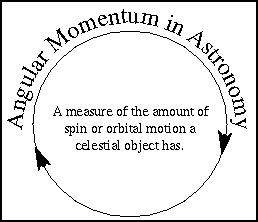This material (including images) is copyrighted!.
See my copyright notice for fair use practices.

Definition
To describe how things move we often use the basic quantities of length,
mass, and time. Quantities such as velocity, acceleration, force and energy
are very powerful ones that help us understand how an object's position will
change over time and how it will interact with other things in the universe.
Momentum and its cousin angular momentum are other very powerful
quantities.
Ordinary momentum is a measure of an object's tendency to move at
constant speed along a straight path.
Momentum depends on speed and mass. A train moving at 20 mph has more momentum
than a bicyclist moving at the same speed. A car colliding at 5 mph does not
cause as much damage as that same car colliding at 60 mph. For things moving in
straight lines momentum is simply mass ×
speed. In astronomy most things move in curved paths so we generalize the idea
of momentum and have angular momentum. Angular momentum measures an object's
tendency to continue to spin. An ``object'' can be either a single body or two
or more bodies acting together as a single group.
angular momentum = mass × velocity × distance (from point object is
spinning or orbiting around)
Very often in astronomy, the object (or group of objects) we're observing has
no outside forces acting on it in a way to produce torques that would disturb
the angular motion of the object (or group of objects). A torque is
simply a force acting along a line that is off the object's spin axis. In these cases,
we have conservation of angular momentum.
conservation of angular momentum---the total amount of angular momentum does
not change with time no matter how the objects interact with one another.
A planet's velocity and distance from the Sun will change but the
combination of speed×distance will not change unless another
planet or star passes close by and provides an extra gravity force.
 Go to next section
Go to next section
last updated: 27 May 2001
Is this page a copy of Strobel's
Astronomy Notes?
Author of original content:
Nick Strobel

